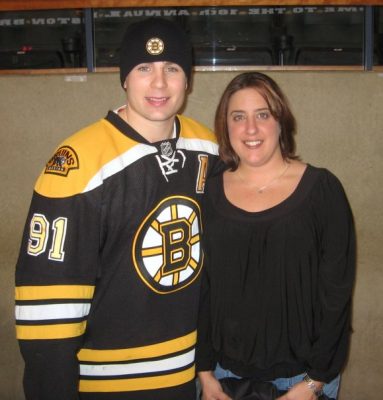
By: Gayle Troiani | Follow me on Twitter @LadyBruinsFan
It was Saturday afternoon, May 1, 2010. Game one of the Eastern Conference Semifinals between the Boston Bruins and Philadephia Flyers was knotted at four at the end of regulation.
Someone was going to be the hero, and fans on both sides of the puck held their breath waiting for the game-winning goal, and it would be the Boston fans celebrating.
After missing the previous 18 games because of a concussion, Marc Savard jumped on the ice for a delayed penalty at 13:52, outracing a Flyer defender to a loose puck and hitting a slapshot past Brian Boucher under the crossbar, giving the Bruins Game one victory.
Savard only played 41 games in the 2009-10 season due to several injuries he sustained, starting with a broken foot just seven games into the season and culminating with a shoulder to the head hit from former Penguin Matt Cooke.
Savard played only 25 games of the 2010-11 season after missing the first 23 games. He suffered a second concussion on January 23, 2011, shutting down his season and ultimately ending his career.

I was devastated. Savard was only the third athlete I cried over when their careers ended. Cam Neely and Michael Jordan were the other two.
Most fans were excited when former Bruins GM Peter Chiarelli signed Zdeno Chara on the first day of free agency in 2006. Of course, I was excited, but words cannot describe the joy I felt learning Savard would bring his talent to Boston.
Savard didn’t make it onto any of the Bruin All-Time leader lists, but in his five years in Boston, he produced 305 points in 304 games. In addition, he was the quarterback on the powerplay, amassing 102 assists on the man advantage.
I often wonder if he would have become the all-time assist leader had he not taken the hit from Cooke and kept pace with his production.
The first time I met Savard, I was a fan at the now defunct Wives Carnival. I was so nervous about taking my picture with him that I thought I held my breath the entire time. But Savard couldn’t have been nicer. He gracefully took the picture and signed another photo I had with me.

It was like his fans were part of his family. He would listen and smile as they told him stories of games and plays they watched. He would even add a few stories of his own. He was humble and endearing.
Years after he retired, Savard did a signing in Methuen, Mass., in 2017. I was pretty much jumping out of my skin when I heard about it.
It wasn’t long after Savard had written his Player’s Tribune in which he described his post-concussion anxiety and depression, so I was more nervous to see him this time.
I was maybe third in line, pacing back-and-forth in about a five-foot square. I wanted him to be okay. I wanted to see that he didn’t still have the residual effects of his concussions.
He walked in, and I started to cry. Just the sight of him brought me to tears. I had all these emotions because I felt pain for him.
He saw that I was crying, and Victor Andreoli told Savard that I was his biggest fan and was worried about him being in a crowd.
Savard stood up, walked over to me, hugged me, and said, “It’s okay. I’m okay now.”
I let out a heavy sigh and smiled.
Savard has moved on from Boston, but he is still one of my all-time favorite players to wear the spoked-B, and I hope one day to see him behind the bench as an assistant coach or head coach for the Bruins.


Leave a Reply